Feb. 6: Since it was a beautiful warm day, we headed out for kayaking and hiking in Congaree National Park, which is just south of Columbia. Congaree is a bottomland flood plain, essentially a swamp that is successively submerged after rainfalls and has dry areas between rains. It includes many ecosystems. As a result, it is a hotbed of biodiversity.
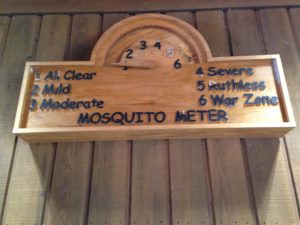 The park is supposed to be teeming with bird and animal life, including alligators and wild boars. Due to the last two, Rumple spent his park visit on leash. We need not have worried however – the only animals sighted were a couple of turtles (not even squirrels) and we might have seen 10 birds. Apparently early February is not prime time for animal and bird life in the park. On the plus side, the insect and spider activity which others complained about was also very subdued. The “Mosquito Meter” is prominently displayed in the visitor center, but we suspect that by the time a visitor has seen it, they already know.
The park is supposed to be teeming with bird and animal life, including alligators and wild boars. Due to the last two, Rumple spent his park visit on leash. We need not have worried however – the only animals sighted were a couple of turtles (not even squirrels) and we might have seen 10 birds. Apparently early February is not prime time for animal and bird life in the park. On the plus side, the insect and spider activity which others complained about was also very subdued. The “Mosquito Meter” is prominently displayed in the visitor center, but we suspect that by the time a visitor has seen it, they already know.
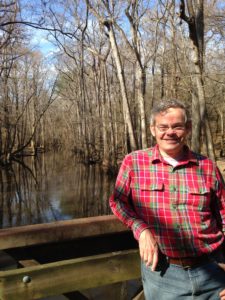 The park brochure suggested a kayak launch site on the Cedar River that can be traversed both up and downstream. The scenery was truly eerie. The sun dappled the murky water through the mature growth. However, most of the trees are tupelos, with weirdly swollen trunks and baldcyprus with flying buttresses at the base of the trunk and large “cypress knees” poking through the mud.
The park brochure suggested a kayak launch site on the Cedar River that can be traversed both up and downstream. The scenery was truly eerie. The sun dappled the murky water through the mature growth. However, most of the trees are tupelos, with weirdly swollen trunks and baldcyprus with flying buttresses at the base of the trunk and large “cypress knees” poking through the mud.
These “knees” which look like dead trunks are actually part of the root system, allowing the roots to survive being fully submerged –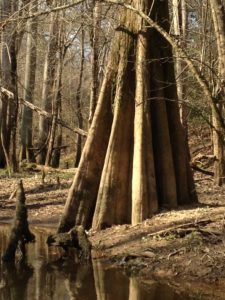 although no-one actually knows what the knees do. In any case, it is easy to imagine a swamp monster emerging from the murk.
although no-one actually knows what the knees do. In any case, it is easy to imagine a swamp monster emerging from the murk.
At this time of year, there are no leaves on the cypress trees, although there were rhododendrons, hollies and palmettos that gave some green to the forest. Spring is beginning here though, and the occasional maple tree keys gave some red color.
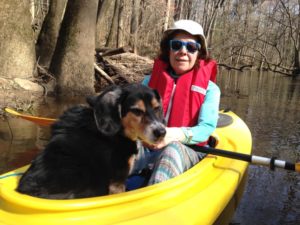 Being safety conscious kayakers, we started our trip by heading upstream. We soon saw the error of our ways, as around the first bend the river was blocked by a fallen log. Getting Rumple in and out of the kayak is not fun, but having no choice, we pulled up on shore. And it was then that we discovered that Congaree mud is more like grease …
Being safety conscious kayakers, we started our trip by heading upstream. We soon saw the error of our ways, as around the first bend the river was blocked by a fallen log. Getting Rumple in and out of the kayak is not fun, but having no choice, we pulled up on shore. And it was then that we discovered that Congaree mud is more like grease …
Chuck tried to step out of the kayak and pretty much ended up rolling in the mud. Rumple did slightly better, and was coated only to his knees (actually ankles). Naomi got out of the kayak OK, and then slithered around on the bank. Needless to say, however, by the time she was back in the kayak with Rumple, a fair amount of his mud made it onto her.
Another bend, and an even more intimidating pile of logs and branches filled the river. We decided to try downstream instead. Of course, this meant disembarking once again to get around the first obstacle. By this time it was pretty clear that getting back in the car without taking a ton of Congaree mud with us was going to be a challenge, but heck, why stop rolling in it once you get to that point?
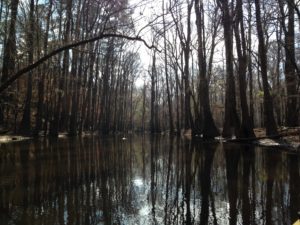 Downstream all was placid and clear. We drifted with the current, spotted turtles, remarked on the weird vegetation and enjoyed the day. We chatted briefly with a couple canoing back upstream, and two young men on a kayak camping trip who had lifted over all the upstream obstacles.
Downstream all was placid and clear. We drifted with the current, spotted turtles, remarked on the weird vegetation and enjoyed the day. We chatted briefly with a couple canoing back upstream, and two young men on a kayak camping trip who had lifted over all the upstream obstacles.
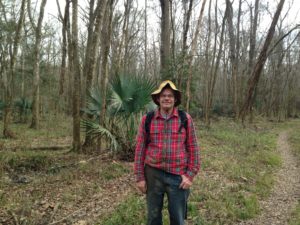 When we had enough kayaking, we paddled back to the landing, reloaded the kayaks on the car, and went for a hike. This trail is supposed to be the primary birdwatching trail, but today it was eerily silent. We saw a single cardinal – otherwise not a single animal bigger than a gnat, and we did not even hear any birds. It was, however, a very nice walk in the woods. The trail is often covered in water, but today was dry. On either side of us, there was a mix of swamp and dry vegetation. The trail is absolutely flat.
When we had enough kayaking, we paddled back to the landing, reloaded the kayaks on the car, and went for a hike. This trail is supposed to be the primary birdwatching trail, but today it was eerily silent. We saw a single cardinal – otherwise not a single animal bigger than a gnat, and we did not even hear any birds. It was, however, a very nice walk in the woods. The trail is often covered in water, but today was dry. On either side of us, there was a mix of swamp and dry vegetation. The trail is absolutely flat.
When we were sufficiently hot and dry, we decided to return to the RV for some food and to clean up. It is not clear that we will have dry shoes tomorrow, but the RV park laundromat took care of the clothes. The kayaks had to be cleaned out with rags and a hose.
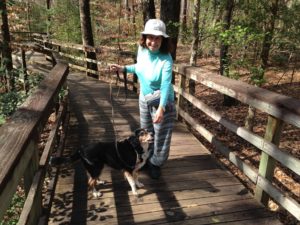
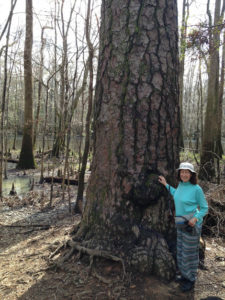
We returned to Congaree the next day and were glad we did. We visited the visitor center and hiked along the board walk – a lovely hike through enormously tall trees. The loblolly pines are particularly huge. As well, the boardwalk has interpretory signs, which were helpful in understanding what is going on.
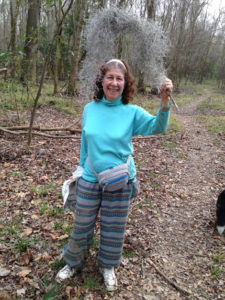
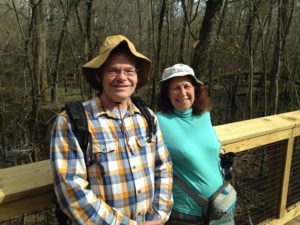
The highlight of the hike occurred at the most scenic spot, Weston Lake, where we started to chat with two other couples. As is often the case, Rumple was the ice breaker, and we started off chatting about pets and travels. After a while, the women moved off, and we started talking with one of the men, Mitch, about his video photography. He had started off when someone left a camera for his wife to do some video-filming. She was intimidated by the equipment, and asked him to take over. That was about 20 years ago, and he has continually upgraded both his equipment and his knowledge. He showed us some of his work, and he is really good, although he claims it is a hobby. Mitch took the nice photo of the 2 of us.
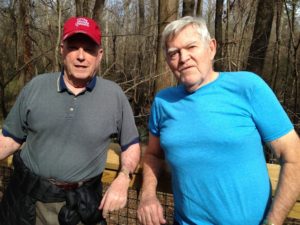 Mitch then started talking about the other man, Jim Howle, who was a Barnum and Bailey clown and an artist. I had never heard of Mr. Howle, but when I had a chance to look him up I realized that I was quite familiar with both his clown act and his art. He was the “sad clown” on the Red Skelton show, and many of his clown paintings are famous. (http://www.charliethejugglingclown.com/Jim%20Howle.htm) In due time, he meandered back to tell Mitch that the wives were getting impatient, but in the end the two of them told us a lot of entertaining stories and jokes about Jim’s career. It was great meeting these two entertaining gentlemen and their wives, and learning a bit about clown art.
Mitch then started talking about the other man, Jim Howle, who was a Barnum and Bailey clown and an artist. I had never heard of Mr. Howle, but when I had a chance to look him up I realized that I was quite familiar with both his clown act and his art. He was the “sad clown” on the Red Skelton show, and many of his clown paintings are famous. (http://www.charliethejugglingclown.com/Jim%20Howle.htm) In due time, he meandered back to tell Mitch that the wives were getting impatient, but in the end the two of them told us a lot of entertaining stories and jokes about Jim’s career. It was great meeting these two entertaining gentlemen and their wives, and learning a bit about clown art.
